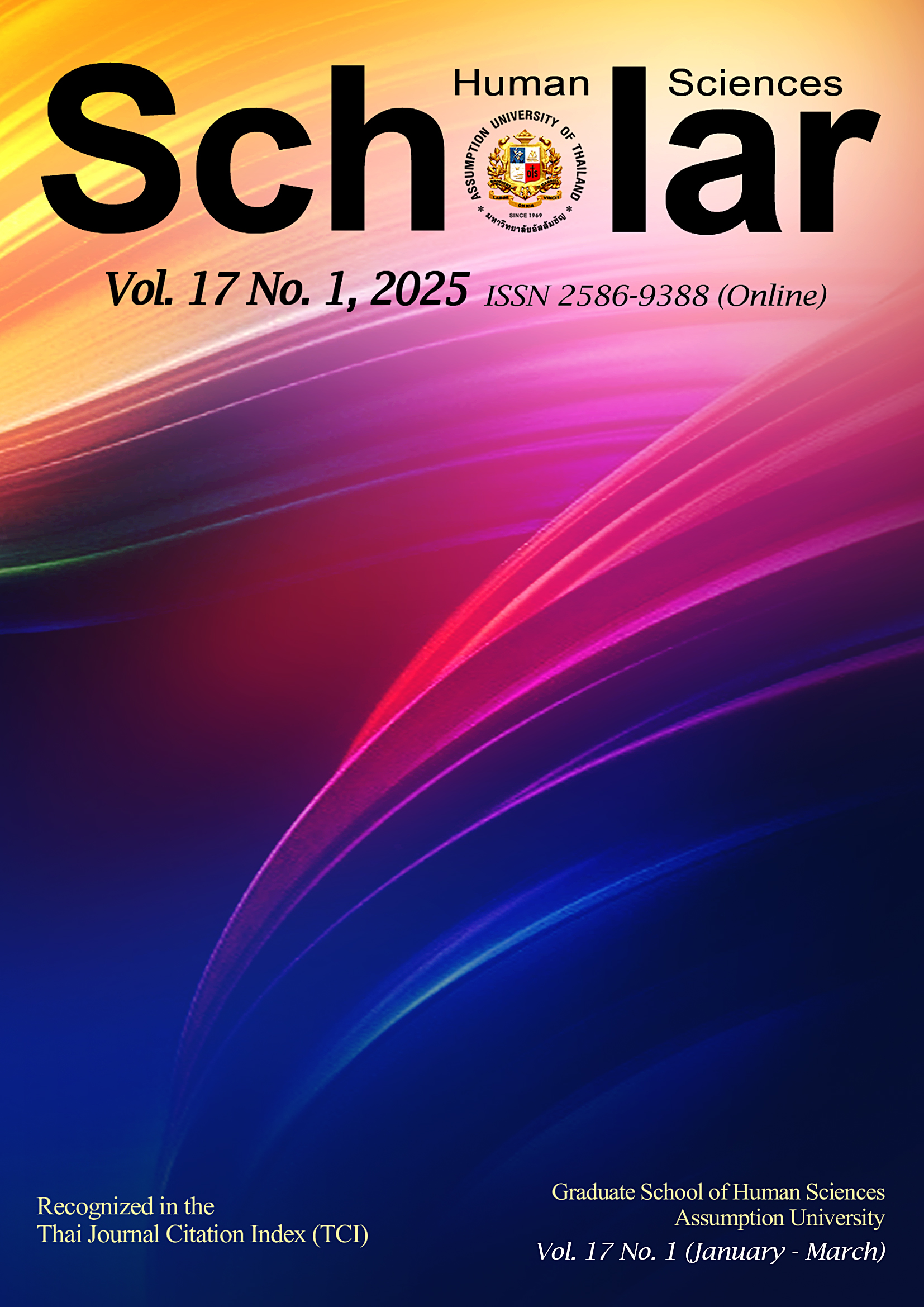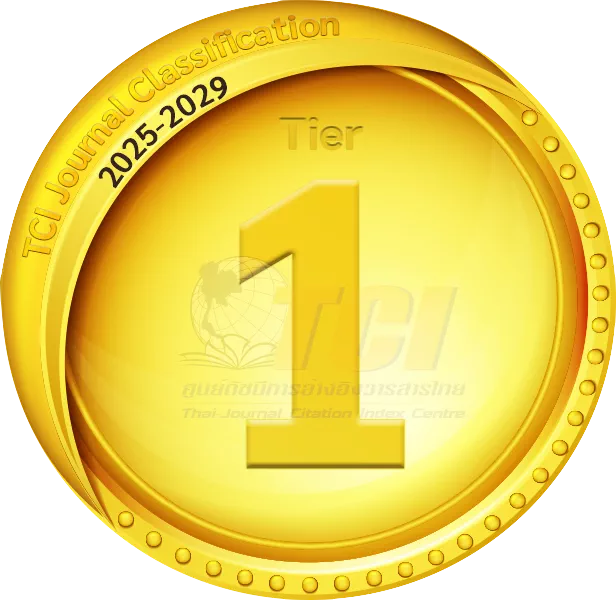Semantics of Cardinal Directions in Benguet Cultural Practices
DOI:
https://doi.org/10.14456/shserj.2025.30Keywords:
Linguistics, Culture, Meaning, Language Education, PhilippinesAbstract
Purpose: Benguet is a province rich in cultural heritage; moreover, the significance of cardinal directions in their cultural practices should be given more attention. This study aimed to identify the cultural practices of Indigenous Peoples in Benguet that incorporated cardinal directions and revealed the meanings of the cardinal directions in these cultural practices. Research design, data, and methodology: A document review was used, and among the 38 documents reviewed, 20 unveiled Benguet cultural practices integrating cardinal directions. These were treated using profiling through descriptive statistics and thematic analysis. Findings: It was revealed that cardinal directions are mainly seen in burial practices, but other practices also used these directions in pig slaughtering, customary law, trading, weaving, and weather forecasting. Constant practice was common in the four cardinal directions; however, each also has its distinct meanings: East is associated with supernatural intervention, eternity, passage to the afterlife, and women’s earthly responsibilities and afterlife authority; North signifies environmental wealth and receptivity; West is linked to discoveries and opportunities, and men’s earthly responsibilities and afterlife disposition; and South means unfavorable meteorological conditions. Conclusions: Therefore, it is concluded that cardinal directions play a significant role in cultural practices in Benguet as they highlight a deep connection between the people's beliefs and these directional aspects of their environment, which are still applied due to their lasting cultural significance.
References
Afable, P. O. (1975). Mortuary ritual among the Ibaluy. Asian Folklore Studies, 34(2), 103. https://doi.org/10.2307/1177628
Agcaoili, A. (2008). The Ilokano language: History, culture and structure: from language to philosophy (last part). https://tawidnewsmag.com/the-ilokano-language-history-culture-and-structure-from-language-to-philosophy-last-part/
Alupias, E. B., Gayao, B. T., Meldoz, D. T., & Sagpa-ey, J. S. (2020). Kinds, Uses, and Implications of Woven Ethnic Materials of The Benguet People. Benguet State University Research Journal, 64(1), 36-54.
Anacin, C. G. (2008). To the Ibaloi spirits we “play”: A descriptive and socio-cultural analysis of Ibaloi death ritual, music and performance with emphasis on the symbolic context and representation [Master’s thesis]. University of the Philippines Baguio.
Anongos, S. F. (2015). Artifacts speak: Diversions of Benguet material culture. Benguet State University Research Journal, 73, 19-31.
Aroco, A. (2017). Ibaloy knowledge through oral tradition. In Fong, J. (Ed.), CHIVA A Reader on Ibaloy History and Culture (pp. 159-166). Cordillera Studies Center.
Atos, M. D. (1987). The culture of the Karao tribe [Doctoral dissertation]. University of Baguio.
Awas, F. (2011). Secularization of the sacred: “Bendian” through the passage of time. Benguet State University Research Journal, 66, 43-74.
Bangle, K. (2009). Cultural differences in wayfinding directions [Bachelor’s thesis, Universiteit Twente].
Barrows, D. P. (1910). The Negrito and Allied types in the Philippines. American Anthropologist, 12(3), 358-376. http://www.jstor.org/stable/659895
Baucas, B. L. (2003). Traditional beliefs and cultural practices in Benguet (1st ed.). New Baguio Offset Press.
Bernard, M. A. (1998). The trial of Rizal. Philippine Studies, 46(1), 46-72. http://www.jstor.org/stable/42633622
Bhat, A. (2023). Exploratory research: Types & characteristics. QuestionPro. https://www.questionpro.com/blog/exploratory-research/#Types_and_methodologies_of_Exploratory_research
Bowern, G. A. (2009). Document analysis as a qualitative research method. Qualitative Research Journal, 9(2), 27-40. http://dx.doi.org/10.3316/QRJ0902027
Brown, C. H. (1983). Where do cardinal direction terms come from?. Anthropological Linguistics, 25(2), 121-161. http://www.jstor.org/stable/30027665
Caligtan-Tran, M. (2022). Et isgeng takos nan sagradoy luta ay naey (let us tread mindfully and live forever on this sacred soil). Alon: Journal for Filipinx American and Diasporic Studies, 2(3), 350-356. https://www.jstor.org/stable/48722253
Camte-Bahni, R. (2018). Rituals of passage in ibaloy death rituals and practices. Journal of Philippine Culture and Society, 8(2), 21-41.
Camte-Bahni, R. (2017). Ibaloy beliefs and values in healing and death practices. In J. Fong (Ed.), CHIVA A Reader on Ibaloy History and Culture (pp. 139-157). Cordillera Studies Center.
Celino, S. M. (1990). Death and burial rituals and other practices and belief in the Cordilleras [Doctoral Dissertation]. University of Baguio.
Chua-Barcelo, R. T. (2014). Ethno-botanical survey of edible wild fruits in Benguet, Cordillera administrative region, the Philippines. Asian Pacific journal of tropical biomedicine, 4(1), 525-538. https://doi.org/10.12980/APJTB.4.201414B36
Clarke, V., & Braun, V. (2013). Teaching thematic analysis: Overcoming challenges and developing strategies for effective learning. The Psychologist, 26(2), 120-123.
Cui, J., Liu, Y., Sun, J., Hu, D., & He, H. (2021). G-STC-M Spatio-temporal analysis method for archaeological sites. ISPRS International Journal of Geo-Information, 10(5), 312. https://doi.org/10.3390/ijgi10050312
Dangpa-Subagan, C. (2009). Kankanaey of Benguet. National Commission for Culture and the Arts.
Delos Reyes, A., & Delos Reyes, A. (1986). Igorot a people who daily touch the earth and the sky. Cordillera Schools Group.
Delos Reyes, C. A. (2017). Mrs. Kelly and the education of the Ibaloys at the Bua School in Benguet, Northern Philippines, 1901-1940. In J. Fong (Ed.), CHIVA A Reader on Ibaloy History and Culture (pp. 35-63). Cordillera Studies Center.
Faričić, J., Kljajić, I., Mirošević, L., & Mlinarić, D. (2023). Symbolism of compass roses on early modern nautical charts of the Adriatic Sea. KN - Journal of Cartography and Geographic Information, 73, 19-37. https://doi.org/10.1007/s42489-022-00129-z
Fry, H. (1982). A history of the mountain province. New Day Publishers.
Gallego, M. K. S. (2019). Directional systems in Philippine languages. Oceanic Linguistics, 57(1), 53-100.
Garambas, C. D., Luna, M. B. Z., & Chua, C. T. (2022). Time-honored praxis in preparing smoked meat delicacy (kinuday) of the Ibaloy indigenous people in Benguet, Philippines. Journal of Ethnic Foods, 9(21), 1-15. https://doi.org/10.1186/s42779-022-00135-6
Gary, A., Lum, J., Poulton, T., & Schlossberg, J. (2017). what in the world is north? translating cardinal directions across languages, cultures and environments. A Journal of Media and Culture, 20(6), 1-7. https://doi.org/10.5204/mcj.1276
Gill, M. (2022). Milton’s cardinal directions symbolism in paradise lost. The Oswald Review: An International Journal of Undergraduate Research and Criticism in the Discipline of English, 24(4), 25-48. https://scholarcommons.sc.edu/tor/vol24/iss1/4
Habana, O. M. (2001). Gold mining in Benguet. Philippine Studies, 49(1), 3-41. http://www.jstor.org/stable/42634434
Hamada-Pawid, Z. (2017). A people’s history of Benguet: the urgency of remembrance and reconstruction. In J. Fong (Ed.), CHIVA A Reader on Ibaloy History and Culture (pp. 1-6). Cordillera Studies Center.
Keith, G. P., & Keith, E. B. (1983). A glimpse of Benguet: Culture and artifacts. Hilltop Printing Press.
Kim, M., Morimoto, K., & Kuwahara, N. (2015). Study on understandability and design elements of cardinal directions. J-Stage, 4(1), 13-20.
Kim, S. (2021). Where is north?: Directionality in precolonial and colonial land surveys in Korea, 1897–1918. Sungkyun Journal of East Asian Studies, 21(1), 105-122. https://doi.org/10.1215/15982661-8873955
Laugrand, F., Laugrand, A., Tamang, J., & Magapin, G. (2020). Exchanges with the sead. Bijdragen tot de Taal-, Land- en Volkenkunde, 176(4), 475-503. https://www.jstor.org/stable/10.2307/26944935
Lusekelo, A. (2018). Terms for cardinal directions in Eastern Bantu languages. Journal of Humanities, 26, 49-71.
MacKinlay, W. E. W. (1904). Some minor languages of Luzon. Journal of the American Oriental Society, 25, 170-174. https://doi.org/10.2307/592557
McCoy, M. D. (2020). The site problem: A critical review of the site concept in archaeology in the digital age. Journal of Field Archaeology, 45(1), 18-26. https://doi.org/10.1080/00934690.2020.1713283
Meldoz, D. T., Gayao, B. T., & Backian, G. S. (2016). Sweetpotato cultivars grown by ethnolinguistic groups in northern Philippines. Benguet State University Research Journal, 76, 13-31.
Morgan, H. (2022). Conducting a qualitative document analysis. The Qualitative Report, 27(1), 64-77. https://doi.org/10.46743/2160-3715/2022.5044
Moss C. R. (2006). Nabaloi law and ritual. University of California Publications.
National Commission on Indigenous Peoples - Cordillera Administrative Region. (2022). Indigenous peoples (IP) groups per municipality/province.
National Commission on Indigenous Peoples - Cordillera Administrative Region. (2017). Documentation of the customary practices on birth, marriage, and death of the Kankana-eys in Buguias, Benguet, Philippines. Benguet Provincial Library.
NCIP-CAR. (2017). NCIP-CAR, CIPC prepare for IP Month. https://mirror.pia.gov.ph/news/2022/08/30/ncip-car-cipc-prepare-for-ip-month
Norris, R. P., & Harney, B. Y. (2014). Songlines and navigation in Wardaman and other Australian aboriginal cultures. Journal of Astronomical History and Heritage, 17(2), 141-148.
https://doi.org/10.48550/arXiv.1404.2361
Pelila, J. R. O. (2020). Benguet folktales: Bases for tracing family bloodline? International Journal of Linguistics, Literature and Translation, 3(4), 1-17. https://doi.org/10.32996/ijllt.2020.3.4.1
Prill-Brett, J. (2017). Tradition and change in Ibaloy customary law. In J. Fong, (Ed.), CHIVA A Reader on Ibaloy History and Culture (pp. 91-124). Cordillera Studies Center.
Province of Benguet. (2020). Discover Benguet. https://benguet.gov.ph/v4/page_id=523#:~:text=Benguet%20was%20established%20as%20a, government%20was%20in%20Tuel%2C%20Tublay
Raza, A., Fatima, G., & Nayab, D. E. (2023). Community learning centres in Afghanistan and Mongolia: A document review. Journal of Development and Social Sciences, 4(3), 855-864. http://dx.doi.org/10.47205/jdss.2023(4-III)78
Rivera, E. G. (1989). The rituals of the Ibaloys: Their implications to education 1988-1999 [Master’s Thesis]. Baguio Central University..
Russell, S. D. (1989). The grand cañao: Ethnic and ritual dilemmas in an upland Philippine tourist festival. Asian Folklore Studies, 48(2), 247. https://doi.org/10.2307/1177920
Sacla, W. (1987). Treasury of beliefs and home rituals of Benguet. BCF printing Press.
Supreme Court. (2017). G.R. No. 213948: Knights of Rizal vs. DMCI Homes, Inc., DMCI Project Developers, Inc., City of Manila, National Commission for Culture and the Arts, National Historical Commission of the Philippines, 2017. https://lawphil.net/judjuris/juri2017/apr2017/gr_213948_2017.html
Tapang, B. (2017). Face/off: reflections of the Ibaloy in historical texts. In J. Fong (Ed.), CHIVA A Reader on Ibaloy History and Culture (pp. 7-33). Cordillera Studies Center.
The City Government of Baguio. (2020). About Baguio city [Official Website]. https://www.baguio.gov.ph/about-baguio-city
University of the Philippines Open University. (2018). Online subscriptions. https://library.upou.edu.ph/online-subscriptions/
White, R. (2009). Ibaloy of Benguet. National Commission for Culture and the Arts.
Downloads
Published
How to Cite
Issue
Section
License
Copyright (c) 2025 John Rey Pelila, Von Ameri Escobar, Jessa Mariel Pilorin, Geraldine Wakat

This work is licensed under a Creative Commons Attribution 4.0 International License.
The submitting author warrants that the submission is original and that she/he is the author of the submission together with the named co-authors; to the extend the submission incorporates text passages, figures, data, or other material from the work of others, the submitting author has obtained any necessary permission.
Articles in this journal are published under the Creative Commons Attribution License (CC-BY What does this mean?). This is to get more legal certainty about what readers can do with published articles, and thus a wider dissemination and archiving, which in turn makes publishing with this journal more valuable for you, the authors.




